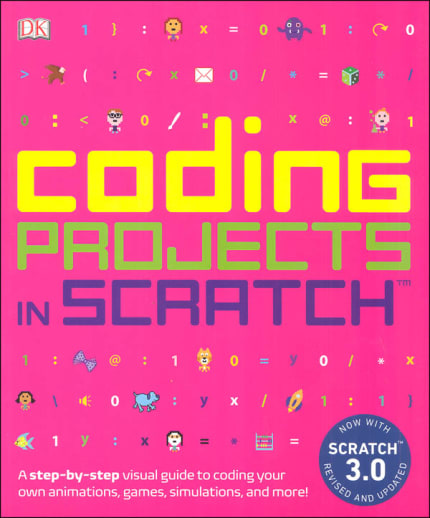A more cohesive guide to Scratch as a programming language, covering art, music, and sound with chapters on Games, Simulations, and Mindbenders. 224 pages, pb.
Coding Projects in Scratch
Description
A step-by-step visual guide to creating your own projects using Scratch 3.0.
Techy kids will get familiar with Scratch 3.0 using this beginner's guide to coding. Difficult coding concepts become fun and easy to understand as budding programmers build their own projects using Scratch 3.0, the latest software from the world's most popular programming language for beginners.
Make a Dino Dance Party or create your own electronic birthday cards. Build games, simulations, and mind-bending graphics as you discover the awesome things computer programmers can do with Scratch 3.0. Coding Projects in Scratch, 2nd Edition, uses a visual step-by-step approach to split complicated code into manageable, easy-to-digest chunks so that the most impressive projects become possible.
Suitable for complete beginners, this book will give readers a solid understanding of programming, preparing
them to create their own projects from scratch, and even move on to more complex programming languages like Python.
Labeled as Step-by-step visual guides to coding, these DK guides are certainly the friendliest introductions to programming Ive seen! Designed for younger students new to coding, these books serve as introductory-level guides for both programming in general as well as Scratch and Python. A brief introduction to the language and topic sets the stage before students embark upon projects of gradually-increasing complexity. Relevant illustrations (helpful and humorous!), line each and every page, accentuating the given topic and adding a touch of fun to keep kids engaged. Text is divided into simple bullet paragraphs which play off the provided drawings perfectly. Once actual projects come into play, these paragraphs are numbered and illustrated with screenshots to mimic what the student will be seeing on the screen. Captions, arrows, and other guides provide further aid during crucial steps.
In addition to these simple nuances, the material within each book is more than adequate for introductory coding. A rather lengthy Getting Started/First Steps chapter in each book provides basic tools and an intro to the language within the context of simple programs. Students are briefly introduced to a concept or function, and then they follow along in creating a program that uses that concept or function. Once its created, students are usually asked to modify it to add greater functionality rather than write a new program. Finally, students apply the knowledge theyve gained to create cohesive games and projects. Its a wonderfully seamless system, and certainly one I wish I had in my early coding books!
| Product Format: | Binder |
|---|---|
| Grades: | 3-7 |
| Brand: | Dorling Kindersley |
| ISBN: | 9781465477347 |
| Length in Inches: | 9.1875 |
| Width in Inches: | 7.75 |
| Height in Inches: | 0.5625 |
| Weight in Pounds: | 1.5 |

